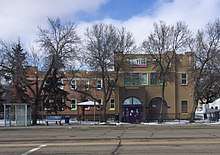Youth Empowerment & Support Services
Youth Empowerment & Support Services, commonly referred to as YESS, is a youth empowerment and housing organization in Edmonton, Alberta, Canada.[1][2][3]
 YESS headquarters at 9310 82 Avenue | |
| Formation | 1978 |
|---|---|
| Type | Not-for-profit |
| Location | |
Region served | Edmonton metropolitan region |
President | Margo Long |
| Website | https://yess.org/ |
History
YESS first registered as a not-for-profit in 1978, although its youth shelter at 9310 82 Avenue in Edmonton did not open until 1981.[4][5]
Services

In 2016, YESS introduced the tagline "YESS is more than a shelter." Although YESS provides housing for at-risk youth in the Edmonton Capital Region, the organization is also dedicated to providing individualized support that addresses both diversion out of homelessness and general prevention of homelessness.[6][7]
Buildings
The YESS buildings are located at 9310 82 Avenue in Edmonton, including the main shelter, a gazebo, and several storage buildings.[8] The main building was built in 1905 as a fire hall for the communities surrounding Mill Creek Ravine.[8] In 1949, the main building became a men's shelter. YESS moved into the building in the early 1980s.[8] In 1986, Edmonton company Rainbow Metal Products built eves, gutters, soffit, and fascia for YESS, whose buildings are now recognized for their Late Art Deco architectural style.[9]
Region served
YESS is located in Edmonton's French Quarter, also known as Bonnie Doon.[10][lower-alpha 1] The neighborhood is home to Edmonton's Franco-Albertan community and contains the only francophone university and the only Francophone high school west of Manitoba, namely the University of Alberta's Campus Saint-Jean and École Maurice-Lavallée.[12] Although YESS is a community organization located within a recognized ethnic enclave in Edmonton, it serves youth from throughout the Edmonton metropolitan region.
Notes
- YESS is located in the western part of Bonnie Doon, which was originally part of the City of Strathcona dating back to 1907 and became a part of Edmonton when Strathcona and Edmonton merged in 1912. The remaining land in the neighbourhood was annexed by the city of Edmonton in 1908.[11]
References
- Forbes, Rayanne (July 3, 2013). "Heart of the City: YESS taking the NEXUS step". Edmonton Examiner. Retrieved 2020-04-05.
- "Discovering one of Edmonton's hidden gems: YESS". edmontonjournal.com. September 13, 2012. Retrieved 2020-04-05.
- "Transgender Edmonton teen calls on all shelters to adopt LGBTQ guidelines". Global News. Retrieved 2020-04-05.
- "Our History – YESS". Retrieved 2020-04-05.
- Truscott, Dave (October 4, 1992). "YES Set To Build". The Edmonton Journal. p. 14.
- Rosove, Jay (2020-03-31). "Support services group finding new ways to help at-risk youth through COVID-19 crisis". Edmonton. Retrieved 2020-04-05.
- "Youth emergency shelter has a Christmas wish list". Edmonton Journal. Retrieved 2020-04-05.
- Lenz, Ken (December 7, 1983). "Shelter Provides Alternative to Street-Life". The Gateway.
- Tingley, Ken (2012). Building a Legacy: Edmonton's Architectural History. Coteau Books. p. 202.
- "Inspired by nativity story, Edmonton churches raise $1 million to alleviate homelessness". Grandin Media. 2019-06-10. Retrieved 2020-06-04.
- Neighbourhood description in the map utility on the City of Edmonton web site.
- Fédération des communautés francophones et acadiennes du Canada, Profil de la communauté francophone de l'Alberta, Géographie, p. 1 : « Dans la ville d'Edmonton elle-même, le secteur de Bonnie Doon, site de nombreuses institutions francophones, revendique le titre de quartier français. »